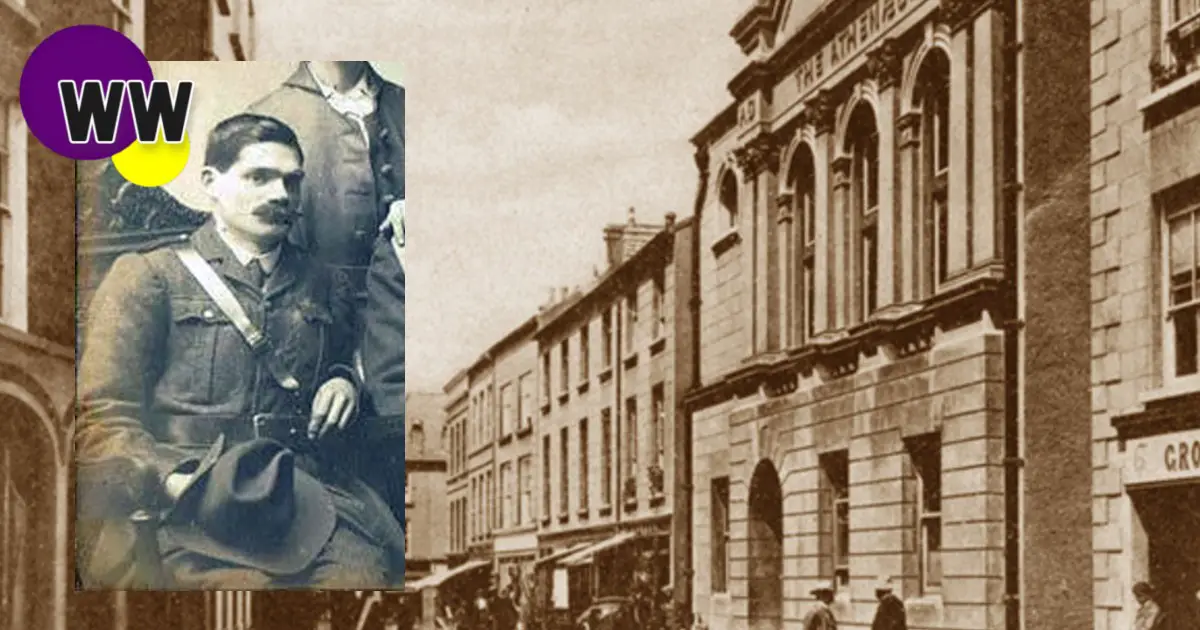Easter week in Ireland is a time in which we remember those who gallantly struck a blow for Irish freedom during the Easter Rising of 1916…
During the commemorations, there is a tendency to focus solely on the Dublin Rising and its leaders. The focus on Dublin is entirely understandable; the Dublin rising saw the most success and indeed it was in Dublin where the heaviest fighting occurred and where the heaviest losses were taken.
However, as a consequence of this, the smaller risings which occurred across the country and their leaders are continually overlooked. One such Rising occurred in Enniscorthy and among its daring leaders was a man by the name of Seamus Rafter.
Nationalist beginnings:
Seamus Rafter was born in Monalee, Ballindaggin near the town of Enniscorthy on he 18th of January 1873. He was born to Martin and Mary Rafter. From an early age, nationalistic principles were instilled into Seamus.
Seamus began attending the local school in Ballindaggin in 1879; there were two teachers in the two school at the time, Mr. Patrick O’Callaghan and Mr. Philip O’Brien. The former, Mr. O’Callaghan was nationalistic in his outlook, he was by no means a radical nationalist, but instilled the ideas of nationhood and a love of Ireland and her culture into his students.
Rafter’s mother was by all accounts deeply patriotic too. The school curriculum only covered English history, however, Mrs. Rafter encouraged her son to read of Ireland’s history and the sacrifices which the Irish people had made for their freedom in the past.
Enniscorthy:
In 1888, Rafter began living in Hayes’ in Enniscorthy. Enniscorthy of course is and was a town shrouded in Republican heritage. The town stands in the shadow of Vinegar Hill where the rebel forces of 1798 made their valiant last stand.
The legacy of ’98, alongside a strong Fenian and nationalist movement which had prospered throughout the town in the 1800s, made Enniscorthy a nationalist stronghold. It was in Enniscorthy where Rafter became deeply involved in the nationalist movement.
He began attending history classes, lectures, and debates. He was accepted into the inner circle of Fenian veteran Charlie O’Farrell. O’Farrell had been the ambassador of the Fenian movement to France and as such spoke fluent French.
Rafter had already picked up Irish very quickly and was fluent in the language. On top of this, he began to take French classes so he could converse with O’Farrell in French.
The IRB and GAA centre was established in Enniscorthy in 1890 on Mary Street in Enniscorthy and their headquarters would become known as ‘Antwerp’.
Rafer became involved with the Irish Republican Brotherhood and was elected as Secretary of the GAA club in Ballindaggin in 1901. Having served his apprenticeship at Haye’s Rafter opened a grocery shop on Duffry Street, trading under the name ‘Rafter Brothers’. This initial venture was so successful that Seamus went on to purchase Bridge House, Slaney Place, from which he ran a grocery shop which doubled as a public house. He also helped to form a branch of the Gaelic League in Enniscorthy.
Irish Volunteers:
The Irish Volunteers were formed in 1913 in response to the formation of the Ulster Volunteer Force and in defence of Home Rule. Although Rafter would have had a more radical vision for Ireland than mere Home Rule, IRB members such as Rafter joined the Irish Volunteers and were among the more radical members of the Irish Volunteers. Rafter formed the first Volunteer company in the country which was famously known as ‘A Company’.
Following the outbreak of World War I, a split occurred in the Volunteers, around 90% of the membership sided with Irish Parliamentarty Party leader and Wexford native, Mr. John Redmond MP, these men opted to fight in Europe and became known as the National Volunteers. The other side regrouped under Professor Eoin McNeill and pledged that they would continue to drill for Ireland, they remained under the name of the Irish Volunteers. Seamus Rafter sided with McNeill and the Irish Volunteers.
Easter Rising:
As the commanding officer of A Company, Rafer had his men well drilled and well disicplined. Padraig Pearse gave a lecture in March of 1916 on Robert Emmet and following this lecture, Pearse arranged a signal with Seamus Doyle, which would inform the Enniscorthy Volunteers the Rising would go ahead as planned.
The signal was sent by Pearse in the lead up to Easter Week 1916, however Chief of Staff of the Irish Volunteers, Eoin McNeill, issued orders to call off the Rising in the Sunday Independent. To add to the confusion, in line with McNeill, Pearse told the Enniscorthy rebels the Rising would not go ahead.
In secret Pearse as a member of the IRB Council arranged for the Rising to take place on Easter Monday. However, the secrecy which surrounded these new plans and the lack of convenient means of communication at the time meant as far as the Enniscorthy rebels were concerned the Rising was still off.
When news of the Rising reached Enniscorthy, the Wexford Brigade were still skeptical and refused to mobilise their forces. On the other hand, Rafter and the Enniscorthy volunteers opted to take part in the Rising.
On the 27th of April 1916, the Athenaeum, Enniscorthy Castle and other key areas were seized by Seamus Rafter and his men. Rafter and his fellow officers used the Athenaeum Theatre as their base of operations.

Until the 1st of May, the town remained under rebel control and by all account Rafter and the other leaders of the Enniscorthy Rising ran a tight ship. Pubs were closed, checkpoints were established, the local Royal Irish Constabulary Barracks was surrounded and there was little to no looting.
Arms were scarce. Many civilians joined the Volunteers, but some went without weapons or armed with just pikes. The tricolour was raised over the Athenaeum, Enniscorthy was the only place aside from the Dublin where the tricolour was raised by rebels during the Rising.
The Enniscorthy Rising saw no fatalities and following confirmation of Padraig Pearse’s surrenderm Rafter along with the fellow leaders of the Rising surrender the town to Crown Forces under Colonel French.
Rafter was arrested and on the 2nd of May was sentenced to death. On the 15th of May, his sentence was commuted to five years in prison. He arrived in Dartmoor Prison in England on the 22nd of May. Having spent little over a year in prison, Rafter was released in June of 1917 and was greeted by a rapturous reception upon his arrival back in Ireland.
Death:
Rafter continued his work within the Republican movement for the remainder of his life. In the end, it was not a British bullet that would cause Rafter to lose his life but a tragic accident on Mary Street.
As well as being the HQ of the Volunteers in Enniscorthy, ‘Antwerp’ on Mary Street was used to manufacture munitions for the Volunteers. On the 29th of August, 1918 as Rafter was coming down the stairs there was a sudden explosion.
Seamus Rafter was seriously injured and succumbed to his injuries on the 12th of September. There was a widespread outpouring of grief for a man who had been the beating heart of the republican movement in Wexford, he was revered by the Volunteers in Wexford as their leader and in many ways it could be said that the Wexford republican movement never truly recovered from the loss of its leader.
His funeral drew a considerable crowd of mourners, it was said at the time that it was one of the largest funerals Wexford had ever seen. He was laid to rest in Ballindaggin, a large number of uniformed Volunteers attended the funeral.
Commemoration:
There are many memorials to Seamus Rafter in county Wexford, many of which are found in Enniscorthy. Following the establishment of the Free State, George’s Street, Enniscorthy, was renamed to Rafter Street. In 1958, a granite statue was erected in Abbey Square in memory of Rafter. The newer bridge in Enniscorthy, which opened in 1991, was also named the Seamus Rafter Bridge. The Enniscorthy Branch of the Gaelic League was named Craobh an Reachtairigh (Rafter Branch) in his honour.

Sources:
Kiely, Des. Famous Wexford People in History. Belfast: Parsifal Press, 2018.
Rafter, Seamus. Seamus Rafter: The Life and Times. Enniscorthy: Courtney Design and Print, 2016.
Value our site? Register NOW for as little as €3 per-year…
For a €3 Subscription, click here.
For a €6 Subscription, click here.
Enjoy our content? Want to keep reading it? By registering, you will have access to all of Wexford Weekly’s content and you’ll also be supporting a growing independent brand. We thank you for your continued support. It costs less than one cent per day to register on Wexford Weekly. If you value our site, we really appreciate it.
– Access to all content
– Improved, premium features
– Discounts on products
– First to know about future buses
– Discounts on future events
Read also:
Remember to submit your news to Wexford Weekly! To advertise on our socials or website, email our team at info@wexfordweekly.com



